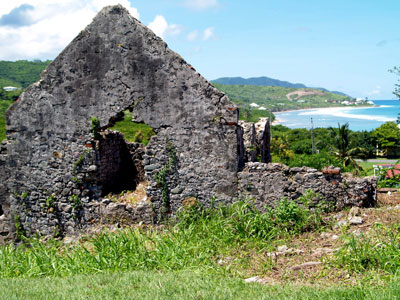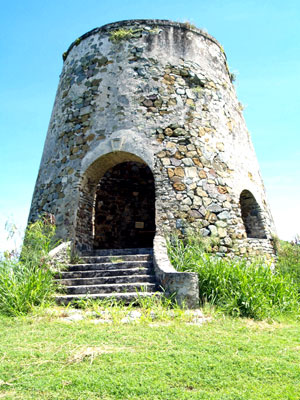|

Ruins of an eighteenth century
plantation house on the northern coast of St. Croix
(Orla Power 2006) |
Overall, it is clear
that the Irish community was adept at maintaining familial
alliances while liaising with Danish officials and
merchants of various nationalities when required. Both
Baker and Tuite spoke some Danish. However, where language
barriers existed, solutions were readily found and
adopted. Hardware goods imported for the sugar and rum
producers ‘Bodkin, Skerrett and Ferral’ did not have
corresponding Danish nomenclature. As such, in the
official records, a degree of syncretic interaction is
apparent. For instance, a technical apparatus relating to
the distillation process, such as the Swan Neck,
[16] was directly translated as a ‘Svan Halse’. Similarly,
articles associated with the production of ‘Killdevil’
such as ‘Killdevil pans’ were prefixed, in Danish, by the
phonetic ‘Kieldyvel’.
[17]
Apart from involvement
in the principal trade in sugar to the Danish metropole,
Irish individuals at Saint Croix often used sugar and rum
in transactions with traders from other islands. For
instance, Theobald Bourke imported 28 fads of unrefined
and 20 fads of refined sugar from French Granada in March
1760. [18] Similarly, Captain John Kennedy exported 18
fads of rum to the Dutch Saint Eustatius in May of that
year. [19] Irish merchants trading to New York, Montreal
and beyond matched such inter-island trade, and reveal the
global reach of mercantile operations on the island.
The Metropole
McCusker describes a
complicated financial exchange zone which existed between
Copenhagen, Amsterdam and Hamburg. For example, a London
merchant who wished to purchase a bill on Copenhagen would
have had to negotiate through Hamburg or Amsterdam, as
there were few or no bills for sale on Copenhagen (McCusker
1978: 81). This shows the extent to which Copenhagen was
dependent on other European capitals in the ambit of
international trade. It is probable that this was a factor
that influenced the prevalence of non-Danish nationals in
positions of influence in Copenhagen. Danish reliance on
European finance ensured opportunities for well-connected
individuals within the Atlantic World who were willing to
engage with unfamiliar territory.
Overall, without London,
the Irish Atlantic mercantile world would have floundered
(Truxes 2006). Contacts frequently tied to a merchant’s
familial network furnished financial services to clients
in far-flung regions. Individuals such as Isidore Lynch
and John Kirwan, both of Galway families, managed bills of
exchange and sourced venture capital as required. Given
that London was one of the most important markets within
the international sugar industry, allegiances with
influential brokers involved in the trade were an
essential aspect of maintaining and appreciating one’s
wealth and affluence. It was common for planters who had
‘over-wintered’ in the Caribbean to return to the
metropole for a few months in the spring.
[20] This was
regarded as a time to socialise, reinforce business
arrangements and to enjoy the trappings of success. Soon
after her return to London in July 1757, Mary Ryan and her
sister bought assorted silks at Mr Palmer’s on Ludgate
Hill (Yorke 1931: 98) and her husband, John Baker, met
Nicholas Tuite at Lloyd’s coffee house and later dined at
Mr Kirwan’s (Yorke 1931: 105).
|

Sugarmill
(Orla Power 2006) |
However, as the Irish
presence at Saint Croix gained in significance, Copenhagen
came to join London as another metropole on the
Irish-Caribbean horizon. Trips to London also became
opportunities to meet Danish representatives of the King.
[21] In 1760, John Baker and Nicholas Tuite both travelled
to Copenhagen where Tuite ‘drank chocolate with the
Imperial Minister’ (Yorke 1931: 142). Theobald Bourke, who
composed his will in Copenhagen in 1770, was granted a
‘Facultas Istandi’ by King Christian VII at his Royal
Palace at Christianborg (Will Bourke). Similarly, the will
of Laurence Bodkin and his wife Jane was recorded in
Danish and registered in the Chancery Rolls at Copenhagen
in 1763 (Will Bodkin). Meanwhile, Nicholas Tuite was
accorded a special honour by the Crown and his son, Robert
was granted the status of Chamberlain to the King of
Denmark (Yorke 1931: 62). The Irish presence at Copenhagen
can also be appreciated in the fact that the sugar
refinery of ‘Selby and Company’, belonging to Nicholas
Tuite’s grandson Charles Selby, was one of the top five
producers in Copenhagen at the end of the eighteenth
century (Sviestrup 1945: 88).
In examining the role
played by Irish individuals in the rapidly expanding and
changing Caribbean marketplace of the eighteenth century,
it is necessary to focus on the commercial relationships
based on kinship, together with those which lay beyond
traditional familial ties. Overall, the methods and
motivations that engaged and built alliances with ‘the
other’ are essential in our understanding of the region
during this time. In concentrating on the kinship network
alone, it would appear that all roads led to London.
However, by searching for alternate spheres of influence
and the ways in which the network adapted to suit the
rigours of the Caribbean market, it is possible to chart
the Irish journey on the fringes of the familiar. Such an
approach may further elucidate the duality of commercial
liaisons displayed by Irish settlers at Saint Croix.
Similarly, in using this approach, it is hoped to shed
light on the settlers’ own sense of identity, perceptions
of ‘otherness’ and notions of ‘Irishness’.
Orla Power
National University of Ireland, Galway |


